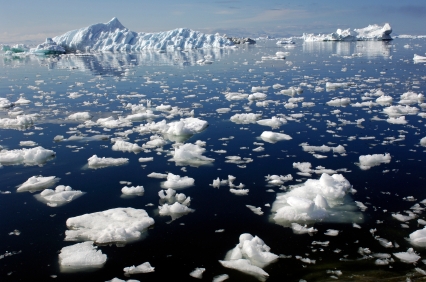We’ve been talking a lot about the ice loss in the Arctic. It’s a broadly understood marker of climate change, an immediately tangible metric that shifts every day (it hit a new all-time low yesterday!).
But this year’s unprecedented melt could also have direct effects on you this year.

From Nature:
[T]his year’s record sea-ice melt might foreshadow a harsh winter in parts of Europe and North America. Recent research, although preliminary, suggests a connection between late-summer Arctic sea-ice extent and the location of areas of high and low atmospheric pressure over the northern Atlantic. The highs and lows can remain relatively fixed for weeks, shaping storm tracks and seasonal weather patterns such as extended cold surges.
Ralf Jaiser, a climate scientist at the Alfred Wegener Institute for Polar and Marine Research in Potsdam, Germany, found a significant correlation in 1989–2011 meteorological data between late-summer Arctic sea-ice extent and atmospheric-pressure anomalies that favour extreme weather such as prolonged cold snaps in winter. He reasons that in autumn, the open Arctic Ocean sheds heat to the high-latitude atmosphere. The warming tends to reduce the large-scale atmospheric-pressure gradient and weakens the dominant westerly winds in the Northern Hemisphere. Those winds normally sweep warm, moist Atlantic air to western Europe; their weakening leaves the region more prone to persistent cold.
“The impacts will become more apparent in autumn, once the freeze-up is under way and we see how circulation patterns have influenced the geographical distribution of sea ice,” says Judith Curry, a climate researcher at the Georgia Institute of Technology in Atlanta. But, she adds, “We can probably expect somewhere in the mid/high latitudes of the Northern Hemisphere to have a snowy and cold winter.”
Ocean organisms are already seeing an impact.
Arctic biology is already changing, as the retreat and thinning of sea ice allows more sunlight to penetrate the upper ocean and deprives certain species of habitat, says Jørgen Berge, a marine biologist at the University of Tromsø in Norway. For example, the dominant Arctic zooplankton — the copepods Calanus hyperboreus and C. glacialis — are being replaced by Atlantic C. finmarchicus. Meanwhile, Arctic cod (Arctogadus glacialis) is increasingly being out-competed by its larger Atlantic cousin Gadus morhua.
There’s an important point that bears repeating: This is happening faster than we expected.
Computer models that simulate how the ice will respond to a warming climate project that the Arctic will be seasonally ‘ice free’ (definitions of this vary) some time between 2040 and the end of the century. But the observed downward trend in sea-ice cover suggests that summer sea ice could disappear completely as early as 2030, something that none of the models used for the next report by the Intergovernmental Panel on Climate Change comes close to forecasting.
Which should serve as a reminder. Our assessments of impact and predictions of melt are just that: assessments and predictions. What the real effects of the melt of the icecaps will be is basically a guess. But all signs point to it having more of an impact than we’re expecting, not less.



